СОЦИАЛЬНО-ЭКОНОМИЧЕСКИЙ УЩЕРБ ПОСЛЕДСТВИЯ ГНОЙНО-СЕПТИЧЕСКИХ НОЗОКОМИАЛЬНЫХ КАРДИОХИРУРГИЧЕСКИХ ИНФЕКЦИЙ
СОЦИАЛЬНО-ЭКОНОМИЧЕСКИЙ УЩЕРБ ПОСЛЕДСТВИЯ ГНОЙНО-СЕПТИЧЕСКИХ НОЗОКОМИАЛЬНЫХ КАРДИОХИРУРГИЧЕСКИХ ИНФЕКЦИЙ
Научная статья
Настас А.Ф.*
ORCID: 0000-0002-3992-9242
Государственный университет медицины и фармации им. Н.Тестемицану, Кишинёв, Молдова
* Корреспондирующий автор (aliona.nastas[at]usmf.md)
Аннотация
Гнойно-септические нозокомиальные кардиохирургические инфекции являются проблемой для общественного здравоохранения. Большинство внутрибольничных инфекций связаны с диагностическими исследованиями, процедурами и медицинскими приборами. Исследование показало, что средняя стоимость лечения одного больного составляет 29238,23 MDL для пациентов без гнойно-септических нозокомиальных кардиохирургических инфекций, 34465,04 MDL для пациентов с гнойно-септическими нозокомиальными кардиохирургическими инфекциями, 53832,84 MDL для пациентов с гнойно-септическими нозокомиальными кардиохирургическими инфекциями в ассоциациях. Дополнительные расходы, связанные с лечением и пребыванием пациентов с гнойно-септическими нозокомиальными кардиохирургическими инфекциями в стационаре, составляют 9851016,18 MDL. Общая сумма лет, потерянных для пациентов умерших от сердечно-сосудистыми заболеваниями с гнойно-септическими нозокомиальными кардиохирургическими инфекциями в 2010-2013 годы, составляет 293 года, что представляет собой экономический ущерб для Республики Молдова 5137101,03 MDL. Суммарный экономический ущерб в результате гнойно-септических нозокомиальных кардиохирургических инфекций, на период исследования с 2010 по 2013 год, составляет 53111959,61 MDL.
Ключевые слова: Гнойно-септические нозокомиальные кардиохирургические инфекции, экономический ущерб, затраты на лечение, эпиднадзор, эпидемический процесс.
THE SOCIO-ECONOMIC IMPACT OF POST CARDIAC SURGERY PATIENTS WITH SEPTIC-PURULENT NOSOCOMIAL INFECTIONS
Research article
Nastas A.T.*
ORCID: 0000-0002-3992-9242
Testemitanu State University of Medicine and Pharmacy, Chisinau, Moldova
* Corresponding author (aliona.nastas[at]usmf.md)
Abstract
Cardio-surgical septic-purulent nosocomial infections represent a major problem for public health. Most hospital infections are those related to diagnostic explorations, related procedures and/or medical devices.
The study has shown that the average cost of treatment per capita represents 29,238.23 MDL for patients without cardio-surgical SPNI, 34,465.40 MDL for patients with cardio-surgical SPNI, 53,832.84 MDL for patients with cardio-surgical SPNI with associations. Additional costs related to treatment and the stationary stay of cardio-surgical patients with SPNI is a total of 9,851,016.18 MDL. The total amount of lost years in deceased post cardio-surgical patients with SPNI for the years 2010-2013 is 293 years, representing an economic loss to the Republic of Moldova of 5,137,101.03 MDL. Full economic impact due to morbidity through post cardio- surgical SPNI during the study period 2010-2013 is a total of 53,111,959.61 MDL.
Keywords: cardiac surgery, septic-purulent nosocomial infections, economic impact, treatment costs, surveillance, epidemic process.
Introduction
Septic-purulent nosocomial infections (SPNI) are one of the most common important public health issues. The reality of this problem at first refers to the widespread extent of these infections with a significant impact on psychological, social and economic consequences [2].
According to the European Center for Disease Control and Prevention (ECDC) nearly 4,131,000 patients are affected annually by HAI’s (Hospital Acquired Infections) in Europe, the number of episodes amounts to the figure of 4,544,100 corresponding to the spread of 7.1%. HAI ranks 10th among causes of death in the US. According to the data from the Center for Disease Control (CDC), the number of HAI cases per year is 1.7 million, of which 99,000 end up with death, and the economic impact amounts to nearly 30 million dollars [3], [4].
In France, for example, hospitalization in patients with HAI is prolonged three times, and the risk of lethality increases by 4-5 times [5,4]. In the EU it is possible to prevent 750,000 medical errors per year, which means reducing the duration of hospitalization by 3.2 million days, the number of serious errors by 260,000 and deaths by 95,000. According to the CDC, there are over 500,000 infections in the US annually due to surgery [6]. Surgical infections increase by 60% in intensive care admissions, five times in case of re-admission, and double the possibility of mortality compared to untreated patients [7]. Another US study to determine the incidence of surgical site infections and its economic impact, demonstrated the relationship between extending the length of stay in hospital and increasing the cost of treatment and addition of nearly 1 million days of hospitalization and 1.6 billion dollars excess costs [8]. In Germany, it was estimated that approximately 2.4 billion euro is spent annually for the treatment of these infections [9].
As a result of a study evaluating socio-economic significance through septic-purulent intra-hospital infections, it was found that economic damage only in the city of Chisinau (1994) amounted to 16,038,000.00-23,328,000.00 MDL annually, an average of 19,683,000.00 MDL, without accounting for any fatal cases, additional remuneration for the work of the staff, and also without discounting morbidity through such infections as flu, viral acute respiratory diseases, pneumonia, and others [10].
At present, there is no calculation methodology in the Republic of Moldova in order to measure the economic impact and human health damage resulting from health care associated infections, although there are a dozen publications written on this topic.
The purpose of the current study was to determine the socio-economic impact as a result of septic-purulent nosocomial cardio-surgical infections.
Material and methods
The research was conducted by actively detecting SPNI cases, after patients received cardiac surgery, by the method of retrospective analysis of medical records of stationary patients hospitalized in the Cardiac Surgery Department of Acquired Vices of the Republican Clinical Hospital (RCH) "Timofei Moşneaga" during the period 2010-2013. A total of 1,332 patient records were studied.
Calculation of the economic and social impact was made by calculating the costs incurred by RCH as a result of cardio-surgical SPNI. The cost of staying in the cardiosurgical department was calculated according to the tariffs for medical-sanitary services approved by the Government Decision no. 1020 of 29 December 2011 "Regarding on tariffs for sanitary services", after formula [1]:
Cst=T×Nz
Where:
Cst- living expenses,
T- price per capita according to the Catalog,
Nz- the number of days in the stationary.
Treatment costs in the cardiosurgical department were calculated according to the delivery orders of medicines, medical items for each patient, in the years 2011-2013 with the modeling of the expenses incurred on the entire study period, according to the formula:
Ctr=(Cbon×Nt)/N
Where:
Ctr - stationary treatment costs,
Cbon - the expenses according to delivery orders of medicines,
Nt – the total number of cases with SPNI treated in stationary,
N - the number of patients with the delivery orders of medicines.
Full economic impact due to morbidity through post cardio-surgical SPNI during the study period 2010-2013 was calculated using the formula:
Iei=Ctr+Cpd+Cst+Cpm+Cf+…+.
where:
Iei - the full economic impact,
Ctr - stationary treatment costs,
Cpd - Expenses in the form of damage to the state,
Cst - cost of living (maintenance) in the stationary,
Cpm - Expenses in the form of moral damage,
Cf - lost family expenses following SPNI deaths.
Results
During the years 2010-2013 in the cardiac surgery department of RCH 1,332 patients have received treatment, of those 143 (10.74%) received conservative treatment, and 1,189 (89.26%) received surgical treatment. This treatment ratio, conservative/surgical approach, is approximately the same in the years 2010, 2011, 2012 and 2013, with a range of only 1-2%. After reviewing the medical documentation, a total of 423 cases with SPNI were detected, including five cases with SPNI that received conservative treatment (1.18%), 418 cases of SPNI that received surgical treatment (98.82%). It is worth mentioning that in the years 2010 and 2013 the registered SPNI patients, 127 and 99 respectively, all (100%) received surgical treatment. The instances of morbidity through SPNI over the period 2010-2013 is 317.6 per 1,000 patients. The incidence of SPNI in patients treated conservatively during this period is 34.97‰, in those treated surgically it is 351.56‰, being 10 times higher (figure 1).
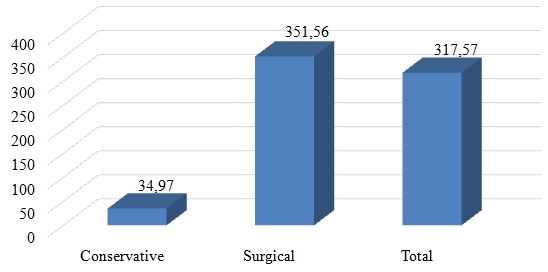
Fig. 1 – Incidence through ISPN in the cardiac surgery department of total RCH in treated patients conservative and surgical, during the years 2010 - 2013 (%)
Incidents of SPNI between 2010 and 2013, in cases of inpatient cardiac surgery, reported to CPH were 15.02‰ or 21.15 times lower than the actual incidence (317.57‰). In 2010, the incidences reported to the CPH were 7.58‰, 42.31 times lower than the actual incidences registered for that year (320.71‰), in 2011 it was 13.61‰, 25.24 times lower than the actual incidences (343.54‰), in 2012 the incidences reported to the CPH were 3.65‰, or 96 times lower than the actual incidences registered that year (350.36‰), the incidences in 2013 reported are 32.61‰, 8.2 times lower than the actual incidences (269.02‰) (Figure 2).
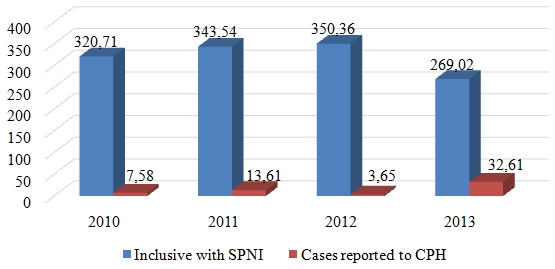
Fig. 2 – Overall incidence by actual cardio-surgical ISPN and reported to CPH mun. Chisinau (%)
During the years 2011-2013 bills were presented on medical records to 533 patients, accounting for 48.0% of all patients treated surgically throughout the study period. Of the 533 patients with the bill of payment, 174 or 31.5% are cardio-surgical patients without SPNI, 291 patients or 52.7% are with SPNI, 68 patients or 12.3% with SPNI and associations. At the same time, these 533 patients represent 174 or 27.0% of patients without SPNI, 291 or 69.7% of patients with SPNI, 68 or 75.6% of patients with SPNI and associations. According to payment invoices analyzed in the department of cardiac surgery for 2011-2013, the average of the cost of treatment per capita was 29,238.23 MDL for patients without SPNI, 34,465.04 MDL for patients with SPNI, 53,832.84 MDL for patients with SPNI and associations. The mathematical model used, is based on the costs incurred in treatment of post cardio - surgical patients, including patients with SPNI, throughout the study period 2010-2013 (Table 1).
Table 1 – Estimated expenses in treatment of cardiac surgery patients during the years 2010-2013
| Categories | No. of patients 2010-2013 | Cost per capita | Amount spent | Days treated | Care per day fee | Extra costs |
| Without ISPN | 646 | 29,238.23 | 18,887,896.58 | 24.24 | 1,206.20 | 0 |
| With ISPN | 418 | 34,465.04 | 14,406,386.72 | 34.71 | 992.95 | 4,345,605.96 |
| With associations | 90 | 53,832.84 | 4,844,955.60 | 39.60 | 1,359.42 | 1,879,263.00 |
| Total | 1,154 | 38,139,238.90 | 6,224,868.96 |
For the treatment of cardio-surgical patients during the period 2010-2013, 38,139,238.90 MDL were spent, of which 19,251,342.32 MDL or 50.48% were spent to treat patients with SPNI, of those, 14,406,386.72 MDL or 74.9% spent on treating patients with single SPNI, 4,844,955.60 MDL or 25,1% spent on treating patients with SPNI with associations.
The cost of the day/bed per capita in the treatment of patients with unique SPNI is 992.95 MDL, of those with SPNI with associations is 1,359.42 MDL, of the patients without cardio-surgical SPNI is 1,206.20 MDL (Figure 3).
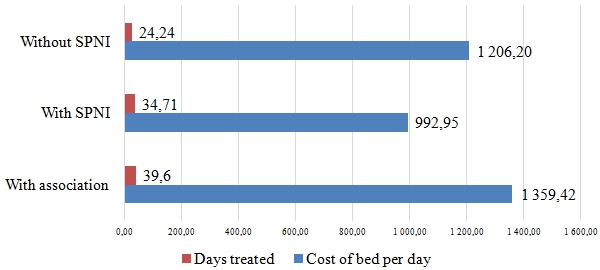
Fig. 3 – Average length of stay in days and cost of bed per day (MDL) for the treatment of cardiac surgery patients
Thus, treatment of stationary patients with single SPNI increased by 10.47 extra days compared to patients without SPNI, increasing expenditures of 4,345,605.96 MDL or 30.2% of the total cost of treatment of the post cardio-surgical patients with SPNI. For the treatment of SPNI patients with associations who were stationary 15.36 additional days were required compared to patients without SPNI, with additional costs of 1,879,263.00 MDL or 48.0% of the total cost of treatment of these patients. For the treatment of patients with unique SPNI and with associations, additional expenses of 6,224,868.96 MDL or 17.0% in addition to the total costs for the treatment of cardiac surgery patients were paid.
The length of stay of patients that acquired SPNI on the day of the cardiac surgery is much longer than those that did not acquire SPNI on the day of their surgery. The average for the years 2010-2013 was 10.47 days/bed for each patient with unique SPNI and 15.36 days/bed for patients with associations. Additional costs related to the stay of patients with unique SPNI was 1,308,561.54 MDL, as a result of the cost of a day/bed equal to 299 MDL according to the Price List, of those with SPNI with associations the cost was 413,337.60 MDL. Total amount of additional expenses related to the stationary stay of patients with unique SPNI and with associations was 1,721,899.14 MDL. Cost of surgical treatment of SPNI by performing 1, 2, and 3 surgeries represent 1,904,248.08 MDL for the additional 126 surgeries performed, and the average cost of a surgical procedure was 15,113.08 MDL.
As a result, the additional expenses related to treatment and stationary stay of cardio-surgical patients with SPNI totals 9,851,016.18 MDL, including 6,224,868.96 or 63.24% treatment-related expenses, 1,721,899.14 MDL or 17.5% for the extra days of stay (cost of day/bed) and 1,904,248.08 MDL or 19.26% surgical treatment costs with 1, 2 and 3 surgeries (Figure 4).
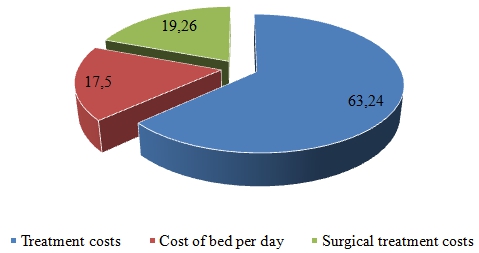
Fig. 4 – Structure of additional expenses incurred in the cardio-surgical department during the years 2010-2013 (%)
In the Cardiac Surgery Department of Acquired Heart Defects over the years 2010-2013, 37 patients or 90.24% of the 67 patients died 48 hours after surgery, of those, 30 or 81.9% were with SPNI. Ages of deceased patients with post cardiac surgery SPNI ranged from 36 to 73 years. Most deaths were at the age of 62 with four deceased patients representing 13.38% of the patients. Two patients died at ages of 36, 41, 48, 53, 60, 63, 68, respectively representing 6.67% of the patients. For ages 43, 44, 49, 51, 52, 55, 56, 59, 69, 71, 73, one patient died for each age category, representing 3.33% of the patients.
Following the deaths of patients with post cardio-surgical SPNI, years of life lost depending on the age of the patients is shown below (Figure 5).
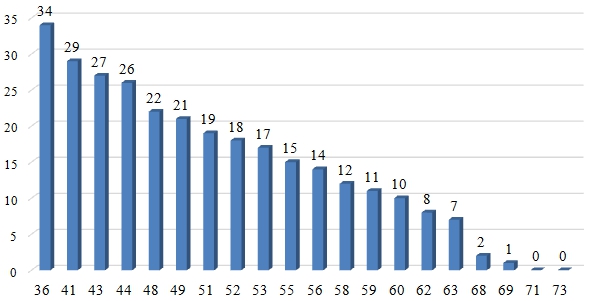
Fig. 5 – Years of life lost depending on the age of the patients in post cardiac surgery SPNI during the years 2010-2013
The benchmark used for life expectancy at birth in the Republic of Moldova during the study period 2010-2013 was, for both sexes, an average of 70 years. A patient that died at the age of 36 missed 34 years of his/her young life. The lost year for a 69-year-old patient is one year. The total amount of lost years in post cardiac surgical patients with SPNI for the years 2010-2013 was 293 years.
Based on GDP per capita in the Republic of Moldova in the years 2010-2013 which was an average 996.18 dollars, the economic loss caused by deaths as a result of post cardiac surgical SPNI was $291,880.74 or 5,137,101.03 MDL. The loss of income for families of deceased patients with post-cardiac surgery SPNI represents 12,732,842.40 MDL, when the average monthly salary in the Republic of Moldova was 3,621.40 MDL for the years 2010-2013.
The moral damage to the family and relatives of the patients with cardio-surgical SPNI varies from case to case, but from judicial point of view, the negative impact reaches at least 50,000.00 MDL for each case of SPNI infection according to search results on the internet. The economic impact of moral damages for 508 cases of post cardio-surgical SPNI during the study period 2010-2013 would constitute 25,400,000.00 MDL.
Full economic impact due to morbidity through SPNI post-cardiac surgery during the study period 2010-2013 is a total of 53,111,959.61 MDL (Table 2).
Table. 2 – Distribution of expenses related to morbidity through post cardio-surgical SPNI during the years 2010-2013 (MDL)
| Estimated Expenses Amount | Amount |
| 1. General treatment | 6,224,868.96 |
| 2. Surgical treatment | 1,904,248.08 |
| 3. Hospital maintenance | 1,721,899.14 |
| 4. Economic damage to the State | 5,137,101.03 |
| 5. The amount of loss to the families | 12,723,842.40 |
| 6. Moral damage | 25,400,000.00 |
| Total | 53,111,959.61 |
For expenses related to the general treatment of patients with post cardio-surgical SPNI costs have been 6,224,868.96 MDL or 11.8% of all expenditure. Expenditures of 1,904,248.08 MDL or 3,6% were incurred for SPNI morbidity for surgical treatment with 1, 2 and 3 interventions. The maintenance costs in the hospital for cardio-surgical patients with SPNI were 1,721,899.14 MDL or 3,3%. The economic loss to the state was 5,137,101.03 MDL or 9,7%, the amount lost for the family of deceased with SPNI was 12,723,842.40 MDL or 24,0%, and the loss of the moral value that can be granted to family and relatives was 2,5400,000.00 MDL or 47.6% (Figure 6).
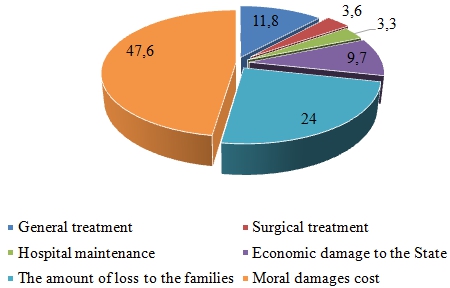
Fig. 6 – Structure of full economic damage related to morbidity due to post cardio-surgical SPNI during the years 2010-2013 (%)
Discussion
The epidemiological study demonstrated the existence of major additional expenditures as a result of septic-purulent post cardio-surgical infection. Expenses related to general treatment of patients with post cardio-surgical SPNI were 6,224,868.96 MDL or 11.8% of all costs related to SPNI morbidity, for surgical treatment with 1, 2 and 3 interventions surgeries were 1,904,248.08 MDL or 3,6%. For in hospital maintenance of cardio-surgical patients with SPNI 1,721,899.14 MDL or 3.3% was spent, the economic loss for the State amounted to 5,137,101.03 MDL or 9.7%, the amount missed for the family of deceased patient was 12,723,842.40 MDL or 24,0%, and the moral damage to the family and relatives was 25,400,000.00 MDL or 47.6%. This finding demonstrates the existence of additional costs related to the presence of septic-purulent nosocomial infections in the Cardiac Surgery Department of Acquired Vices of the Republican Clinical Hospital "Timofei Mosneaga". It is important that these expenses can be optimized only through the implementation of several preventive measures, improvements to the system of surveillance and control of infections associated with healthcare, and to organize the monitoring of the epidemiological situation by taking urgent action, ultimately reducing the risk to post cardio-surgical patients' health.
Conclusion
- Full economic impact due to morbidity through SPNI post-cardiac surgery during the study period 2010-2013 amounts to a total of 53,111,959.61 MDL.
- Expenses incurred as the result of nosocomial septic-purulent infections of cardiac surgery have a major negative economical and psychological impact, requiring urgent prophylaxis actions, changing the surveillance system and control of these infections to optimize spending and reduce negative impact on public health.
| Конфликт интересов Не указан. | Conflict of Interest None declared. |
Список литературы / References
- Ревич Б.А., Сидоренко В.Н. Методика оценки экономического ущерба здоровью населения от загрязнения атмосферного воздуха/ Б. А. Ревич, В. Н. Сидоркенко // М.: Акрополь, 2006, с. 6-42
- Шкарин. В. В. Эпидемологические особенности госпитальной гнойно-септической инфекуии в кардиохирургическом стационаре / В. В. Шакурин 1998, №5, с. 43-47
- Брико Н. И. Эпидемологическая безопасность – важнейшая составляющая обеспечения качества и безопасности медицинской помощи / Н. И. Брико // Весатник Росздравнадзора. № 3, 2014.
- Masud F. Preventing healthcare-associated infections in cardiac surgical patients as a hallmark of excellence. Methodist Debakey Cardiovasc / Masud. 2011 Apr-Jun; 7(2): 48-50.
- Lamarsalle L. Evaluating the clinical and economic burden of healthcare-associated infections during hospitalization for surgery in France / L. Lamarsalle. Epidemiol Infect. 2013 Dec; 141(12):2473-82.
- Center for Disease Control and Prevention, Hospital Infection Control Practices Advisory Committee. Guidelines for Prevention of Surgical Site Infection, 1999. Ann J, Infect control 1999; 27:97-134.
- Bratzler D. W. The Surgical Infection Prevention Guidelines Writers Workgroup. Antimicrobial Prophylaxis for Surgery: An Advisory Statement from the National Surgical Infection Prevention Project. / D. W. Bratzler
- Lissovoy G. Surgical site infection: incidence and impact on hospital utilization and treatment costs / G. Lissovoy Am J Infect Control. 2009 Jun; 37(5): 387-97.
- Frank U. Cost-effectiveness of an antiseptic-impregnated central venous catheter in the ICU / U. Frank. Intensive Care Med. 2003; 29(1): 139.
- Prisacari V. Aspectele economice in tratamentul osteitei posttraumatice / V. Prisacari Sanatate publica, economie și management in medicina. Chisinau, nr.4(15), 2006, p.35-40.[Economic issues in the treatment of posttraumatic osteitis] / Prisacari V. //Public Health, Economics and Management in Medicine. Chisinau, no. 4 (15), 2006. [in Romanian].
Список литературы на английском языке / References in English
- Revich B. A. Metodika otcenki ekonomicheskogo uscherba zdorovʹyu naseleniya ot zagrezneniya atmosfernogo vozduha, Posobie po regionalʹnoy ekologicheskoy politikiyu. - M.:Akropolʹ, TSEPR, 2006, p. 6-42 [Methodology for assessing the economic damage to public health from air pollution, Manual on regional environmental policy] / B. A. Revich, V. N. Sidorenko // M.: Acropolis, CEPR, 2006, p. 6-42. [in Russian]
- Shkarin V.V. i dr., Epidemiologicheskie osobennosti gospitalʹnoy gnoyno-septicheskoy infektsii v kardiohirurgicheskom statsionare. ZHMEI, 1998, N5, s. 43-47 [Epidemiological features of hospital purulent-septic infection in cardiac surgery hospital]/ Shkarin V.V. et al.,// EMIR, 1998, H5, p. 43-47. [in Russian]
- Briko N.I. i dr., “Epidemiologicheskaya bezopasnostʹ – vazhneyshaya sostavlyayuschaya obespecheniya kachestva i bezopasnosti meditsinskoy pomoschi”, Vestnik Roszdravnadzora Nr 3, 2014 [Epidemiological safety is the most important component of ensuring the quality and safety of medical care]/ Briko N.I. et al., //Vestnik Roszdravnadzor Nr 3, 2014. [in Russian]
- Masud F. Preventing healthcare-associated infections in cardiac surgical patients as a hallmark of excellence. Methodist Debakey Cardiovasc / Masud. 2011 Apr-Jun; 7(2): 48-50.
- Lamarsalle L. Evaluating the clinical and economic burden of healthcare-associated infections during hospitalization for surgery in France / L. Lamarsalle. Epidemiol Infect. 2013 Dec; 141(12):2473-82.
- Center for Disease Control and Prevention, Hospital Infection Control Practices Advisory Committee. Guidelines for Prevention of Surgical Site Infection, 1999. Ann J, Infect control 1999; 27:97-134.
- Bratzler D. W. The Surgical Infection Prevention Guidelines Writers Workgroup. Antimicrobial Prophylaxis for Surgery: An Advisory Statement from the National Surgical Infection Prevention Project. / D. W. Bratzler
- Lissovoy G. Surgical site infection: incidence and impact on hospital utilization and treatment costs / G. Lissovoy Am J Infect Control. 2009 Jun; 37(5): 387-97.
- Frank U. Cost-effectiveness of an antiseptic-impregnated central venous catheter in the ICU / U. Frank. Intensive Care Med. 2003; 29(1): 139.
- Prisacari V. Aspectele economice in tratamentul osteitei posttraumatice / V. Prisacari Sanatate publica, economie și management in medicina. Chisinau, nr.4(15), 2006, p.35-40.[Economic issues in the treatment of posttraumatic osteitis] / Prisacari V.// Public Health, Economics and Management in Medicine. Chisinau, no. 4 (15), 2006. [in Romanian].
